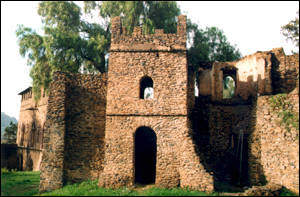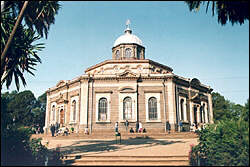 HISTORICAL ROUTE HISTORICAL ROUTE |

Legend has it that Emperor Menelik 1, the son of the Queen of Sheba and king Solomon, brought the Ark of the Covenant from Jerusalem to Axum, where he settled and established one of the world's longest known, uninterrupted monarchical dynasties.
This is only one example of Ethiopia's magnificent history, which encompasses legend and tradition, mystery and fact, from a powerful and religious ancient civilisation. The well-trodden path through Ethiopia's famous and fascinating historic places takes you through a scenically magnificent world of fairy-tale names, such as Lalibela, Gondar, Debre Damo and Bahar Dar.
Travelling the route by plane, by car or both will offer you a glimpse into a truly remarkable past. As will as the many priceless historical relics, you will also see the castles at Gondar, the churches of Lalibela hewn out of the living rock, the mysterious giant stelae at Axum, the ruins of Queen of Sheba's palace, and the monastery at Debre Damo, whose access is limited to men and then only by way of a rope lowered by the friendly monks above.
 GONDAR GONDAR |
Gondar lies 748 kilometres along the route from capital and is also served daily by Ethiopian Airlines. The town has some good hotels. The oldest and most impressive of Gondar's many imperial structures is the palace of Emperor Fasilidas, said to have been built by an Indian architect. There are also numerous other fascinating historical buildings and relics to be seen in the area.

 DEBRE MARKOS DEBRE MARKOS |
Taking the historic route north from Addis Ababa, the first stop is Debre Markos, 305 kilometres north of the capital and also accessible by air three times a week with Ethiopian Airlines. Here you will find the 19th Century church of Markos (Saint Mark), with its pale but beautiful paintings depicting scenes of biblical and religious history.
 BAHAR DAR BAHAR DAR |
Bahar Dar, the next stop, is 578 kilometres from Addis Ababa, has daily Ethiopian Airlines flights and a number of good hotels, and is located on the southern shores of Lake Tana, the source of the Blue Nile, with its ancient island monasteries and both the Blue and the White Niles' most spectacular feature the Tis Isat waterfalls. On the island of Dega Estefanos, you will find the monastery of Dek Stefanos which has a priceless collection of icons and manuscripts and house the mummified remains of a number of Ethiopian emperors.
|  LALIBELA LALIBELA |

The last stop on the route is Lalibela, 642 kilometres from the capital, with daily Ethiopian Airlines flights. Though not much more than a village, Lalibela is internationally renowned for its rock-hewn churches, which are sometimes called the eighth wonder of the world. Carved out of the rock in which they stand, these towering edifices seem to be of superhuman creation in scale, workmanship and concept.
 AXUM AXUM |
Halfway by road to Axum, which has a good hotel and daily flights by Ethiopian Airlines from Addis Ababa you will pass, 1,005 kilometres to the south, Ras Dashen, which, at 4,543 metres, isAfrica's fourth highest mountain. Axum, the northernmost stop along the route, is the site of Ethiopia's most ancient city and is renowned for its Cathedral of St. Mary of Zion, where, as legend has it, the original Ark of the Covenant is housed. Axum is also famous for its seven mysterious monolithic stelae, all made of single pieces of granite and with identical decorations. The biggest of them is 33 metres high and weighs over 500 tonnes. It was the largest monolith in the world but fell at some time in the past.
 MAKALE MAKALE |
On the return journey to Addis Ababa, the route takes you through Makale, 777 kilometres from the capital, with a small but first-class hotel, and with a daily Ethiopian Airlines flight. The town is famous for its rock-hewn churches --- of which there are some two hundred in the region--- which are beautifully decorated. A few of them house important religious artefacts. Makale is also a good place to watch the camel caravans climbing up from the forbidding Danakil Depression with their tablets of salt.
 HARAR HARAR |
Off the oval-shaped almost north-south historical route, is Harar, 523 kilometres due east of Adds Ababa. While the town has a reasonable hotel, most people prefer to stay in Dire Dawa, 54 kilometres away along the road to Addis Ababa. The most dominant features of Harar are its strong encircling walls, which tightly embrace the town, its rich and exciting market place --- probably the most colourful in Ethiopia --- and its 99 Muslim mosques, which make this the fourth most holy city of Islam.
|

